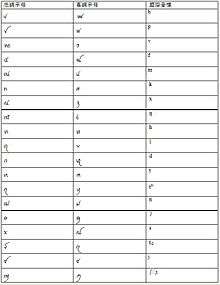Tai Dam language
| Tai Dam | |
|---|---|
| Black Tai | |
| ꪼꪕꪒꪾ | |
| Native to | Vietnam, Laos, Thailand, China |
Native speakers | 760,000 (1995–2002)[1] |
|
Tai–Kadai
| |
| Tai Viet | |
| Official status | |
Recognised minority language in | |
| Language codes | |
| ISO 639-3 |
blt |
| Glottolog |
taid1247[2] |
Tai Dam, also known as Black Tai (Thai: ภาษาไทดำ; pronounced [pʰāːsǎː tʰāj dām]; "Black Tai language"; Chinese: 傣担语; pinyin: Dǎidānyǔ) is a Tai language spoken by the Tai Dam in Vietnam, Laos, Thailand, and China (mostly in Jinping Miao, Yao, and Dai Autonomous County).
The Tai Dam language is similar to Thai and Lao, but it is not close enough to be readily understood by most Thai and Lao speakers. In particular, the Pali and Sanskrit additions to Thai and Lao are largely missing from Tai Dam.[3]
Geographical distribution
Tai Dam is spoken in Vietnam, China, Laos, and Thailand. In central Thailand, it is known as Thai Song.
Tai Dam speakers in China are classified as part of the Dai nationality along with almost all the other Tai peoples. But in Vietnam they are given their own nationality (with the White Tai) where they are classified (confusingly for English speakers) as the Thái nationality (meaning Tai people).
In China, Tai Dam (Chinese: 傣朗姆) people are located in the following townships of Yunnan, with about 20,000 people in Yunnan (Gao 1999).[4]
- Maguan County 马关县: Muchang Township 木厂乡, Dalishu Township 大栗树乡, and Pojiao Township 坡脚乡
- Wenshan County 文山县: Dehou Township 德厚乡, Panzhihua Township 攀枝花乡
- Hekou County 河口县: Qiaotou Town 桥头镇 (in Baihei Village 白黑村 and Gantianzhai 甘田寨)
- Yuanjiang County 元江县: Dashuiping Township 大水平乡 (in Gaozhai 高寨 and Yangmahe 养马河)
Writing system
| Tai Viet | |
|---|---|
| Type | |
| Languages | Tai Dam, Tai Dón, and Thai Song |
| Direction | Left-to-right |
| ISO 15924 |
Tavt, 359 |
Unicode alias | Tai Viet |
The Tai Dam language has its own system of writing, called Tai Viet, which consists of 31 consonants and 14 vowels. Although the language is tonal, there are no tone markers, as there are in Tai and Lao. According to Thai authors, the writing system is probably derived from the old Thai writing of the kingdom of Sukhotai.[3]

Unicode
Proposals to encode Tai Viet script in Unicode go back to 2006.[5] A Unicode subcommittee reviewed a February 6, 2007 proposal submitted by James Brase of SIL International for what was then called Tay Viet script.[6] At the ISO/IEC JTC1/SC2/WG2 meeting on April 24, 2007, a revised proposal[7] for the script, now known as Tai Viet, was accepted "as is", with support[8] from TCVN, the Vietnam Quality & Standards Centre.
Tai Viet script was added to the Unicode Standard in October, 2009 with the release of version 5.2.
The Unicode block for Tai Viet is U+AA80–U+AADF:
| Tai Viet[1][2] Official Unicode Consortium code chart (PDF) | ||||||||||||||||
| 0 | 1 | 2 | 3 | 4 | 5 | 6 | 7 | 8 | 9 | A | B | C | D | E | F | |
| U+AA8x | ꪀ | ꪁ | ꪂ | ꪃ | ꪄ | ꪅ | ꪆ | ꪇ | ꪈ | ꪉ | ꪊ | ꪋ | ꪌ | ꪍ | ꪎ | ꪏ |
| U+AA9x | ꪐ | ꪑ | ꪒ | ꪓ | ꪔ | ꪕ | ꪖ | ꪗ | ꪘ | ꪙ | ꪚ | ꪛ | ꪜ | ꪝ | ꪞ | ꪟ |
| U+AAAx | ꪠ | ꪡ | ꪢ | ꪣ | ꪤ | ꪥ | ꪦ | ꪧ | ꪨ | ꪩ | ꪪ | ꪫ | ꪬ | ꪭ | ꪮ | ꪯ |
| U+AABx | ꪰ | ꪱ | ꪲ | ꪳ | ꪴ | ꪵ | ꪶ | ꪷ | ꪸ | ꪹ | ꪺ | ꪻ | ꪼ | ꪽ | ꪾ | ꪿ |
| U+AACx | ꫀ | ꫁ | ꫂ | |||||||||||||
| U+AADx | ꫛ | ꫜ | ꫝ | ꫞ | ꫟ | |||||||||||
| Notes | ||||||||||||||||
References
- ↑ Tai Dam at Ethnologue (18th ed., 2015)
- ↑ Hammarström, Harald; Forkel, Robert; Haspelmath, Martin; Bank, Sebastian, eds. (2016). "Tai Dam". Glottolog 2.7. Jena: Max Planck Institute for the Science of Human History.
- 1 2 Bankston, Carl L. "The Tai Dam: Refugees from Vietnam and Laos". Passage: A Journal of Refugee Education. 3 (Winter 1987): 30–31.
- ↑ Gao Lishi 高立士. 1999. 傣族支系探微. 中南民族学院学报 (哲学社会科学版). 1999 年第1 期 (总第96 期).
- ↑ Ngô, Việt Trung; Brase, Jim (2006-01-30). "L2/06-041: Unified Tai Script for Unicode" (PDF). Working Group Document, ISO/IEC JTC1/SC2/WG2. Retrieved 2015-05-31.
- ↑ Brase, Jim (6 February 2007). "L2/07-039R: Tay Viet Script for Unicode" (PDF). Retrieved 9 August 2014.
- ↑ Brase, Jim (2007-02-20). "N3220: Proposal to encode the Tai Viet script in the UCS" (PDF). Working Group Document, ISO/IEC JTC1/SC2/WG2. Retrieved 2015-05-31.
- ↑ "N3221: Support for the proposal (N3220) to encode the Tai Viet script" (PDF). Working Group Document, ISO/IEC JTC1/SC2/WG2. 2007-03-21. Retrieved 2017-03-24.